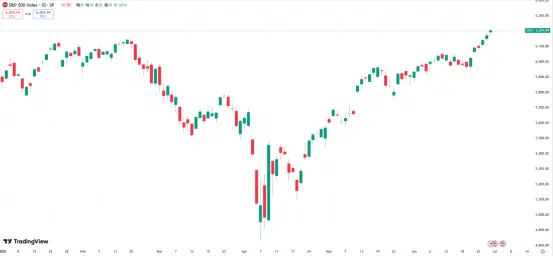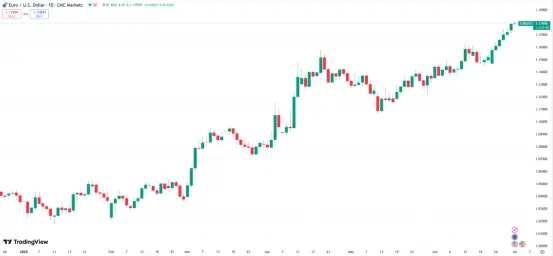EU and US May Reach Trade Accord, Easing Tariff Tensions Ahead of Suspension Deadline
23:30 June 30, 2025 EDT
Key Points:
1. The European Union is reportedly willing to accept a trade deal with the United States that includes a 10% so-called “baseline tariff”
on many EU exports.
2. Earlier, Canada announced it would withdraw its digital services tax in order to reach a mutually beneficial comprehensive trade
agreement with the U.S.
3. On the back of improving trade negotiation prospects, U.S. equities closed out June 30 with strength, with the S&P 500 hitting a new
all-time high.
As the July 9 deadline approaches for the United States’ 90-day suspension of the “reciprocal tariff” policy, the EU and U.S. are intensifying
trade negotiations in an effort to avoid an escalation in tariffs. As of June 17, 2025, the average effective U.S. tariff rate had dropped to
15.8%, down from 27% earlier this year.
Sources say the EU is open to a deal that allows the U.S. to impose a 10% baseline tariff on a broad range of European imports, but is
pushing for commitments from Washington to reduce tariffs on critical sectors such as pharmaceuticals, alcoholic beverages,
semiconductors, and commercial aircraft.
EU Seeks Exemptions for Key Industries
The European Union is working to finalize a trade agreement before the July 9 deadline to avoid the reinstatement of tariffs of up to 50%
threatened by former President Trump on May 23. According to sources, the EU is willing to accept a 10% baseline tariff in exchange for
reductions or exemptions on tariffs for key sectors such as pharmaceuticals, alcoholic beverages, semiconductors, and commercial aircraft.
In addition, the EU is seeking quotas and carve-outs to ease the impact of a 25% tariff on autos and a 50% tariff on steel and aluminum—
especially critical for Germany, a major auto exporter.
However, internal divisions remain within the EU over how far to compromise. Germany, whose auto industry is heavily reliant on the U.S.
market (with €52.8 billion in exports to the U.S. in 2024), is pushing for a quick deal. France, by contrast, insists any agreement must be
balanced—or it will push for reciprocal countermeasures.
On June 26, 2025, European Commission President Ursula von der Leyen expressed optimism at the G7 summit, noting the EU had
proposed a “zero-for-zero” industrial tariff pact, expanded purchases of U.S. energy, and an extension of the U.S. tariff-free access for
lobsters. According to insiders, the EU is aiming for a deal that is “fair to both sides” and provides more predictability for businesses.
If a deal is reached, it would likely take the form of a “Swiss cheese” framework—accepting a common baseline tariff while preserving
exemptions or carve-outs for critical sectors to maintain market access and minimize disruption to key exports.
Still, major differences remain in areas like digital regulation. The EU has explicitly refused to compromise on the Digital Markets Act (DMA)
and the Digital Services Act (DSA). EU spokesperson Thomas Regnier confirmed this stance on June 30. EU Trade Commissioner
Maroš Šefčovič is scheduled to meet with U.S. Trade Representative Katherine Tai and Commerce Secretary Gina Raimondo in Washington
from July 3–4 to advance the negotiations.
Current Status of Tariff Negotiations
On April 2, 2025, President Trump announced a “reciprocal tariff” policy targeting key U.S. trading partners, introducing a 10% “baseline
tariff” and imposing significantly higher rates on select countries—triggering sharp volatility in global financial markets. On April 9, Trump
temporarily paused the imposition of higher tariffs on major partners for 90 days, pushing the effective date to July 9, while maintaining the
10% baseline rate. He warned that if no agreements were reached, previous tariff levels would be reinstated.
As of late June, the U.S. had only reached a framework agreement with the United Kingdom, lowering steel and aluminum tariffs to 25%
while keeping the 10% baseline intact. A deal with China reduced U.S. tariffs on Chinese goods from 145% to 30%, with China reciprocating
by cutting its tariffs on U.S. goods to 10%. However, negotiations with other major partners—including the European Union, Japan, and
Canada—remain deadlocked.
President Trump has continued to send mixed signals in public statements. Treasury Secretary Bessent hinted last week that a final
agreement could be pushed back to Labor Day in September, while Trump declared on social media that he was “terminating” talks with
Canada.
Nevertheless, on June 30, White House National Economic Council Director Kevin Hassett announced that U.S.-Canada trade negotiations
would resume immediately following Canada’s decision to withdraw its Digital Services Tax (DST). The Canadian government stated the
move was intended to help facilitate a mutually beneficial, comprehensive trade deal with the United States.
Market Optimism Builds
Buoyed by improving prospects for a U.S.-EU trade deal, U.S. equities ended June 30 on a strong note. The S&P 500 rose 0.52%, while the
Nasdaq gained 0.47%, with both indexes closing at all-time highs. The second quarter overall delivered standout performance, with the S&P
500 notching its biggest quarterly gain since Q4 2023 and the Nasdaq posting its best quarter in five years, up over 6%.

Source: TradingView
Back in April, markets saw sharp pullbacks following Trump’s tariff announcement. On April 9 alone, the S&P 500 surged 9.5%, underscoring
the market’s sensitivity to tariff developments.
A finalized trade deal or an extension of the tariff deadline could sustain market optimism, particularly for tech stocks, which led June 30
gains with about a 1% advance in the Nasdaq. However, if tariffs were raised to 50%, broad-based selling could return. JPMorgan Research
previously estimated that $5 trillion in market value was wiped out in just two days in April due to tariff fears.
A Yale University study found current tariff levels are already costing U.S. households an average of $4,400 to $4,900 in annual purchasing
power. A 50% tariff could further erode consumer spending. Industries reliant on EU imports—including autos, consumer goods, and
manufacturing—would face higher costs, potentially pressuring corporate earnings and stock prices.
Meanwhile, the euro hit a nearly four-year high against the U.S. dollar on June 30, reflecting investor confidence in a potential U.S.-EU
agreement. However, prolonged uncertainty or tariff escalation could reverse that trend, strengthening the dollar and weighing on U.S.
exporters and multinational corporations.

Source: TradingView
Bottom Line
Investors are placing high hopes on the outcome of the ongoing tariff negotiations. Canada’s recent decision to withdraw its digital services
tax is widely seen as a positive signal—one that suggests the U.S. and EU could also adopt a “give-and-take” approach to avoid escalation.
The outcome of the coming days’ negotiations will likely be a pivotal variable shaping global market direction. A breakdown in talks could
send global tariff levels back to their April 2 highs, dealing a real blow to global manufacturing supply chains, multinational corporate
earnings, and consumer confidence.
Conversely, a successful compromise would help ease pressure on the global economy and could support the continuation of the current
technical bull market in U.S. equities.
Disclaimer: The content of this article does not constitute a recommendation or investment advice for any financial products.

Email Subscription
Subscribe to our email service to receive the latest updates
